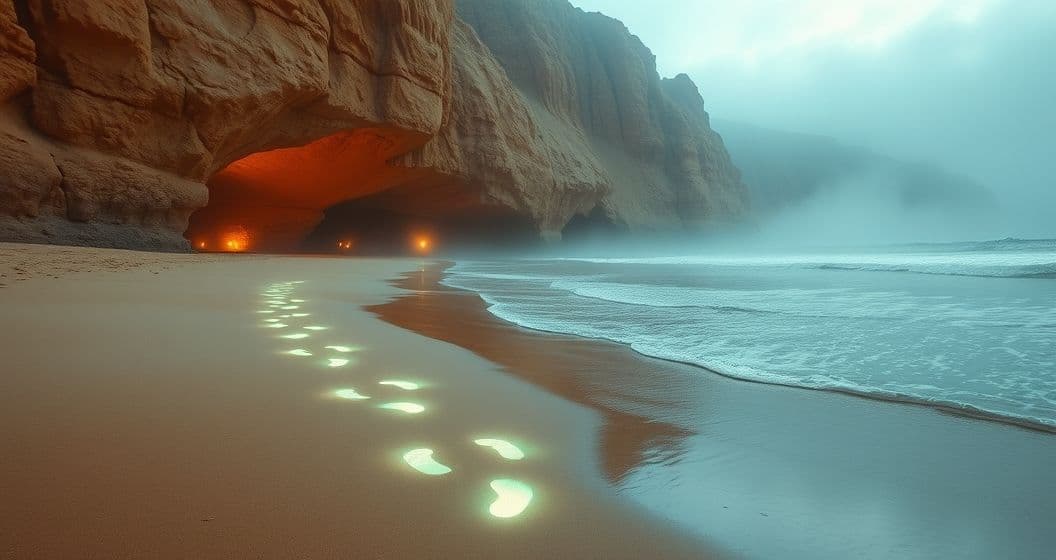Core Symbols: Beach, Footprints, and Chambers
The beach in dreams is rarely just sand and surf—it’s a primal symbol of the unconscious mind, fluid and ever-shifting like emotions. Its vastness represents life’s possibilities, while the shoreline marks the boundary between conscious awareness and deeper, unexamined thoughts. When footprints appear, they carry dual meaning: they’re temporary, like fleeting moments, yet persistent, leaving traces of your journey. These aren’t random steps; they’re the story of choices you’ve made and the ones you’re still considering.
Beach chambers, the final destination, are the heart of the dream’s mystery. Unlike open shorelines, chambers feel enclosed yet inviting—like hidden rooms in a childhood home or the recesses of your mind. They’re not literal caves but metaphors for thresholds: moments of decision, buried memories, or untapped potential. Imagine a dream where footprints curve upward into a cave-like structure, its entrance veiled by mist. This isn’t just a physical space; it’s a portal to parts of yourself you’ve yet to acknowledge.
Psychology Lens: Jungian Archetypes and the Unconscious
Want a More Personalized Interpretation?
Get your own AI-powered dream analysis tailored specifically to your dream
🔮Try Dream Analysis FreeCarl Jung’s concept of the collective unconscious offers rich context here. The beach, with its universal association with water and primal space, taps into humanity’s shared relationship with the unknown—a deep-seated need to explore both external landscapes and internal depths. Footprints, in this framework, represent the anima/animus archetype: the parts of yourself you’ve either embraced or neglected, now guiding you toward integration.
Neuroscience adds another layer: during REM sleep, the brain processes emotional memories, often using symbolic landscapes to organize feelings. If you’ve recently faced uncertainty—a new job, relationship, or loss—the beach chambers might be your mind’s way of processing these changes. The act of following footprints isn’t random; it’s your subconscious trying to make sense of where you’re going and why.
Freud would likely interpret the beach as a manifestation of repressed desires, while the chamber could symbolize a “safe space” for those desires to surface. But modern dream analysis balances these views, recognizing the beach as both a place of release and a mirror for your current emotional state.
Life Triggers: When the Beach Calls
This dream often arises during periods of transition. If you’ve moved, started a new project, or ended a relationship, the beach becomes a metaphor for the unknown. The footprints might be leading you toward a decision you’ve been avoiding—a career pivot, a creative endeavor, or a conversation with someone you care about.
Consider a 30-year-old artist who dreamed of following footprints to a chamber filled with half-finished canvases. She’d recently quit her corporate job to pursue art but felt paralyzed by self-doubt. The dream mirrored her internal struggle: the beach was her new creative freedom, the footprints her tentative steps, and the chamber her unfinished work waiting to be completed. It wasn’t a warning but a nudge to trust the journey.
Daily stressors also play a role. If you feel overwhelmed by responsibilities, the beach’s calm can represent a longing for simplicity, while the chamber hints at a need to retreat and recharge—even if only mentally.
What To Do Next: From Dream to Action
Start by journaling the details: Did the beach feel familiar or alien? Were the footprints yours or someone else’s? How did the chamber look—warm and inviting or dark and foreboding? This reflection helps identify which parts of your life the dream is addressing.
In the medium term, notice recurring “chambers” in your waking life. These might be hobbies you’ve abandoned, relationships needing repair, or goals you’ve shelved. Ask yourself: What would it feel like to step into that chamber today? Small experiments—like taking a new route to work or trying a creative exercise—can bridge the gap between dream imagery and real action.
For long-term integration, create a “beach ritual.” Spend 10 minutes daily visualizing a calm beach, then imagine following footprints to a chamber of your choosing. Inside, see what you need to release or embrace. This practice turns the dream’s symbolic journey into a tangible self-exploration tool.
FAQ
Q: What does it mean if the beach is stormy in this dream?
A: Stormy beaches suggest emotional turbulence—unresolved feelings or fears. The chamber may represent a need to face these storms rather than avoid them.
Q: Why do I keep dreaming of following footprints but never reaching the chamber?
A: This could reflect uncertainty about life direction or fear of commitment. The journey itself is the message: trust the process of exploration.
Q: Are beach chambers always positive symbols?
A: They can be—signaling growth—or negative, indicating avoidance. Context matters: a brightly lit chamber might mean clarity, while darkness could mean unprocessed fears.
